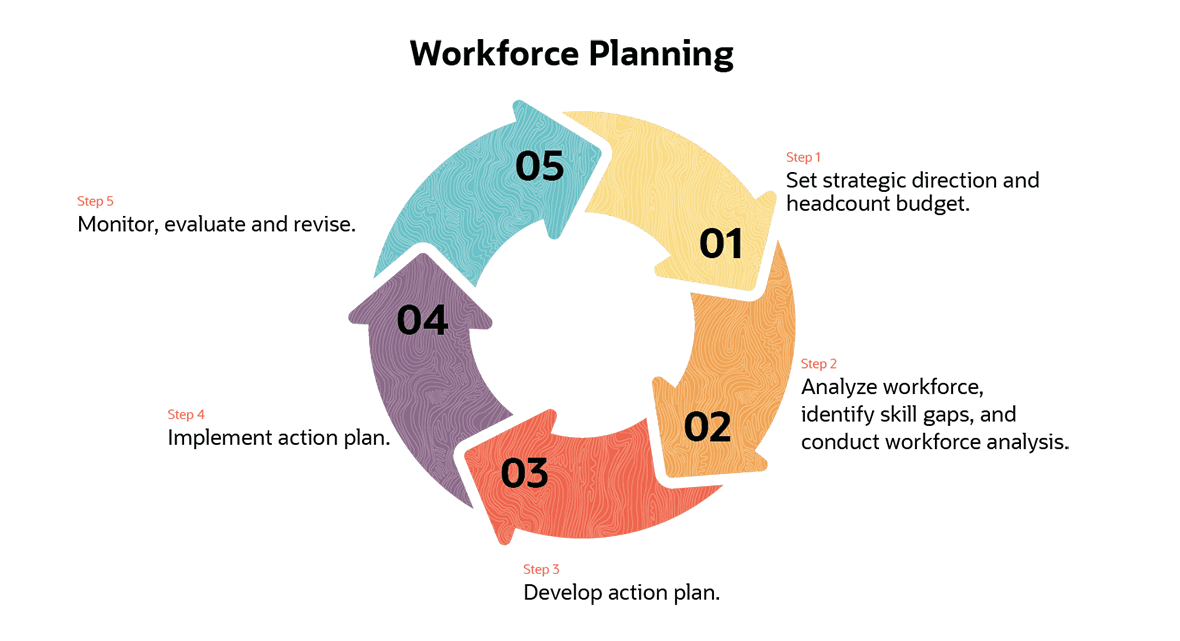In a large company, managing headcount gets complicated fast. Total employees and contractors, approved-to-fill positions, proposed positions, unapproved positions, positions aligned with cost centers, positions not aligned with cost centers, evolving laws, changing pay bands — it’s a complex, critical and sometimes under-resourced element of the budgeting and strategic planning process.
Fortunately, there are best practices to help business leaders and HR teams keep it all straight. Let’s define the problem, then we’ll reveal 10 ways to get better at headcount planning.
What Is Headcount Planning?
Headcount planning, a crucial component of strategic workforce planning, is the process by which companies ensure they have the right people, with the right skills, to meet short- and long-term business goals within an established labor budget. The process requires a cross-functional team of line-of-business leaders, senior executives and HR and finance specialists able to move expeditiously.
Why is there a need for speed? For one thing, it’s not as if workforce costs are static. While the U.S. Bureau of Labor Statistics says that wages and benefit costs increased modestly in Q4 2020, by about 1% and 0.6%, respectively, for civilian employees, most experts believe these costs will continue to rise. And as the economy continues to recover, the available labor pool will shrink. A multidisciplinary team delivers a more complete view of goals and can revise strategy quickly if costs jump, the company’s needs change or the right talent proves elusive.
Headcount Planning vs. Workforce Planning
Headcount planning is fairly straightforward: Do we have enough employees with the right skills in the right positions in the right locations? Workforce planning and analytics includes headcount planning, but that’s just one element.
The U.S. Office of Personnel Management Workforce Management model may be aimed at public-sector agencies, but it’s applicable to private companies with only minor adjustments.

Where Headcount Planning Fits in Workforce Planning
Step 1: Gather data. Pull together the company’s short-, mid- and long-term business plan, budget and strategic goals.
Step 2: Analyze current state. Run a headcount planning exercise to determine the current workforce reality. Identify skills gaps now, total workforce costs, hiring priorities and project through the timespan analyzed in goal-setting exercise.
Step 3: Make a plan. Brainstorm strategies to close gaps, such as training, promotions, restructuring or recruiting, and estimate the cost to staff up properly. Determine the employment type needed for each headcount: full time, part time, contractor, temporary, seasonal or other.
Step 4: Execute. Make sure budgets align with workforce requirements and that HR and hiring managers are communicating and prepared to execute on the plan. Hire, train or reshuffle people.
Step 5: Evaluate & Revise. Monitor progress against milestones, revise plans as needed to stay on track and remain on guard for market or other changes that demand adjustments.
Data: U.S. OP
Any company with questions about how its current and future staffing will support growth will benefit from a workforce planning and analytics effort. This is the process of analyzing the existing workforce in context of business goals, including the composition and skills in place now, any gaps that exist, recruiting and training plans in place and the labor budget.
Workforce planning requires data — performance management, succession planning and more — to analyze both the state of the existing workforce and its suitability to meet future needs. Your goal is to answer the question: “Do our employees have the right skills, and are they in the right roles, to accomplish our mission now and in the future?”
Figuring that out relies on analytics to identify skills gaps in the workforce that introduce risk, drive succession planning and help the business control labor costs.
Headcount planning is a cog in that effort. It is often viewed as a budgeting and allocation exercise and a way to review and refine the org chart and ensure it’s aligned with business strategy and compensation structures, and that’s valid. When positions are mapped to specific pay grades or bands, cost centers, and full compensation including benefits, taxes, incentives and required equipment, you have a solid starting point for workforce planning. Our advice is to focus less on individuals and more on roles. That tends to add clarity into whether existing positions should be eliminated or restructured and how much to budget for new hires.
Why Is Headcount Planning Important in Business?
Headcount planning is important for budgeting, from compensation including wages and benefits to real estate and equipment costs. Robust headcount planning delivers five important benefits:
1. Hiring the right people. Without headcount planning, you risk a misalignment between the strategy that, in some companies, is conveyed to analysts, the press and the board of directors, and the ability to execute.
2. Staying within budget. Just as first-time homebuyers may insist, despite all evidence to the contrary, that they can find a house in their target neighborhood within their budget, some businesses are operating on unrealistic assumptions that they can hire the right people within the approved headcount budget. By bringing together finance and recruiters, headcount planning aligns compensation with the realities of the labor market in which the company is looking for people.
3. Determines the right headcount mix. For example, maybe the business can bring in seasonal or contract employees to keep the business running during seasonal spikes in sales. The company could decide to look into automation to reduce headcount, or it might realize budgets are unrealistic and need to be reworked.
4. There is enough space and equipment for people who are hired. Before many employees transitioned to working from home, growing organizations faced real space constraints. Then, for a while, the pinch was around issuing gear to help people do their jobs from anywhere or updating facilities for safety. In 2023, headcount planning allows businesses to design for what comes next and the space and equipment they will need to accommodate people — and launch conversations about remote and flexible work arrangements going forward.
5. Strengthens compliance readiness. Depending on its situation, a company may need to comply with regulations under the Family Medical Leave Act (FMLA), Medicare, the Affordable Care Act, various taxation structures and more. Headcount planning gives the finance team the visibility it needs to avoid the financial and reputation risks associated with noncompliance.
How to Plan for Business Headcount and Growth
The first step in headcount planning is to get a solid accounting of where the business is at that point in time. Calculating an accurate current headcount may sound simple enough, but it’s often anything but. First, the organization must define what it means by headcount: Who is included, and what data do we need to assign positions accurately? For instance, finance may report and track headcount by cost centers, while HR may sum up headcount based on positions and hierarchies.
Here are basic elements of an employee record. Having all fields complete for each employee and contractor will enable the company to slice and dice data by, for example, home vs. on-site and exempt vs. nonexempt employees.
| Worker Record Template | |
|---|---|
| Worker status | |
| Employee, active | |
| Employee, inactive | |
| Contractor, active | |
| Contractor, inactive | |
| Schedule status | |
| Full time | |
| Part time | |
| Avg hours worked per pay period | |
| Exemption status | |
| Exempt, no overtime | |
| Nonexempt | |
| Avg overtime worked per pay period | |
| Job title | |
| Department/business unit/cost center | |
| Manager | |
| Pay rate | |
| Salary, annual | |
| Hourly rate | |
| Work location | |
| Home worker, state and city | |
| In-office, location | |
| Flex | |
| Sex | |
| Race | |
| Veteran status | |
| Other protected status | |
Modern human resources software adds consistency and efficiency for HR teams that need to rationalize the organization’s headcount structure and reporting processes while also lending functionality to drill into position details and individual cost centers. Look for the ability to roll up to hierarchies for broader views by business unit or function.
10 Headcount Planning Best Practices for 2025
Remember, headcount planning is a component of workforce planning, not a substitute for the broader discipline. Still, solid headcount planning is better than nothing and will eventually drive better workforce planning. Here are ten steps to master the process.
-
Evaluate your current workforce:
Assessing whether the business needs to add or cut positions will be challenging if decision-makers can’t get an accurate view of the current organizational structure. Thus, the data points in our worker record template, along with any business-specific items, comprise the baseline. From here, the business can build headcount models from which they can forecast future workforce profiles and compare them with current state.
Historical data may also reveal, for example, demand spikes at certain times of the year based on seasonal sales cycles that could be addressed with temporary workers or a lack of gender parity in a specific department.
Barriers to evaluating your current workforce include using disparate spreadsheets versus a human resources management system, measuring or classifying people differently in different departments, not accounting for type of position such as exempt and nonexempt and neglecting to count contract and seasonal workers. For this reason, HR software is a foundational tool for headcount planning because it consolidates data in a central location, ensures its accuracy and makes it easy to access and analyze.
-
Encourage whole management participation:
While HR software is a cornerstone of headcount planning, don’t leave all data collection to HR, and don’t leave finance to be the “fall guy” should positions need to be eliminated. Executive and line-of-business manager involvement is absolutely crucial to the planning process. Remember: Workforce composition must be driven by business strategy, consistent with revenue targets and closely aligned with goals. That starts with collaboration and process consistency. Don’t create a culture where managers view adding people as the only means of solving business problems, leaving finance with the unenviable job of denying requisitions. The HR business partner brings to the table an understanding of the unique needs and characteristics of the workforces in the regions in which you operate, as well as the costs and level of difficulty in adding additional headcount.
-
Bring the recruiting team into the process early:
Plans to add people can go south quickly if recruiting, whether an internal function or a contractor, isn’t privy to the business strategy and invested in the planning process. Recruiters bring deep and specialized knowledge of employment market trends and will know whether the skills and seniority sought and compensation planned are in line with reality.
-
Align with business strategy:
If you have not already done so, start talking about where the business wants to go. Strategy must proceed headcount planning, but that strategy can’t be advanced without making sure the headcount strategy is achievable within the current labor market and compensation structure. Compensation planning and recruiting must be closely aligned. Also be mindful of labor trends in your region and industry.
-
Identify skills gaps:
Generate a list of the skills represented within the current workforce and see how that maps to the skills that will be needed to realize growth plans. In addition, evaluate the current workforce in light of HR-related business factors such as turnover, training and succession requirements. Determine what gaps exist between current and projected workforce needs and identify strategies for closing them — including methods that don’t require additional headcount, such as retraining, restructuring and automation.
-
Forecast costs:
Bringing in data on employment market trends is important. If workforce planning includes budgeting for, say, a new developer with specific skills necessary to deliver key product updates and hit revenue targets, the business must factor in the economic and market variables of attracting someone to that job. Consider the availability of people with those skills in your geographic area and industry, salary and benefits expectations and more. Data from the Bureau of Labor Statistics, for example, is helpful in headcount planning by considering the cost of factors that won’t necessarily surface solely by analyzing in-house data, such as average salaries by region.
-
Pull budget information:
Build financial models to match up with headcount plans, and test what-if scenarios. Use your current and historical data to determine total costs for current employees, then extrapolate based on compensation increases, potential new tax nexuses, the results of hiring or reducing headcount over certain time periods, using more contractors and other variables. Build reports that can be shared with decision-makers.
-
Establish and track metrics and KPIs:
Tie strategy to headcount and headcount planning to KPIs. Develop the right metrics and link them to hiring drivers. There are two buckets of KPIs that drive headcount planning: metrics related to recruitment and metrics related to finance. The former includes hiring pipeline conversation rates, such as time-to-fill and source of hire, as well as offer acceptance rates and ways to measure time-to-effectiveness. Finance metrics could include the revenue contributions per position, production per unit of revenue or the cost of an empty seat. These vary depending on company type.
-
Communicate headcount plans:
Even when based on roles, not individual employees, headcount decisions are about people. Job requisitions involve the means for department managers to deliver results. Thus, the headcount planning process tends to be wrapped in emotion. Aim to communicate and act as transparently as possible, consistent with HR rules and the culture of the organization, so that leaders aren’t surprised that they’re not getting an expected headcount addition, or worse, must cut staff.
-
Develop a strategy to track progress:
Make headcount planning dynamic, not an annual one-and-done event. By incorporating financial models, your KPIs and up-to-date workforce data sets, you make headcount planning dynamic and move it from a tactical to a strategic exercise — and one that is much more suited to the current work environment.
Simplify Headcount Planning With NetSuite
Many companies find integrated HR, payroll, and planning, budgeting and forecasting software workforce planning, especially as companies grow and the regulatory landscape becomes increasingly complex. This software can simplify budgeting for compensation, taking into account tax laws and regulations by pulling data from the company’s ERP system. This allows for a single source of data for headcount planning and encourages sustainable, realistic growth plans.
A business can’t drive its strategy forward without the right people. Headcount planning allows the business to shift when conditions in the industry and market demand and forms the foundation for the many elements that go into making the workforce productive, engaged and able to drive increased revenue for the business.
Headcount Planning Best Practice FAQs
Who should attend headcount meetings?
HR, finance, line-of-business managers and executive leaders must be involved from the beginning stages of headcount planning. But one of the biggest mistakes companies make is leaving recruiting out of the initial strategy discussions. And, large enterprises — especially transnationals — must make sure there is someone in the room who understands each region’s unique challenges, needs and opportunities.
What is the ideal timeline for headcount planning?
Midsize to large-enterprise companies typically align headcount planning with the budgeting cycle. But this is not a hard and fast rule, as there are many events in the life of a company that will require close examination of headcount. These include an economic downturn, a merger or an acquisition or as a response to positive market conditions leading to increased demand for the product or service. With the right software and mature processes, headcount planning may become much more frequent.
How do you align corporate real estate planning with headcount planning?
A big part of planning for people is planning space. As demand for remote work grows, these teams are left with some tough decisions: Do people who are able to choose work from home, come back to the office or take the potentially the most popular and cost-effective hybrid approach?
In any case, it’s important to make the facilities team aware of the headcount planning processes and strategies and begin conversations early on how to accommodate those plans. This could include retrofitting existing space, sharing workstations or offices, looking into leasing a new space or accommodating more remote work arrangements.









